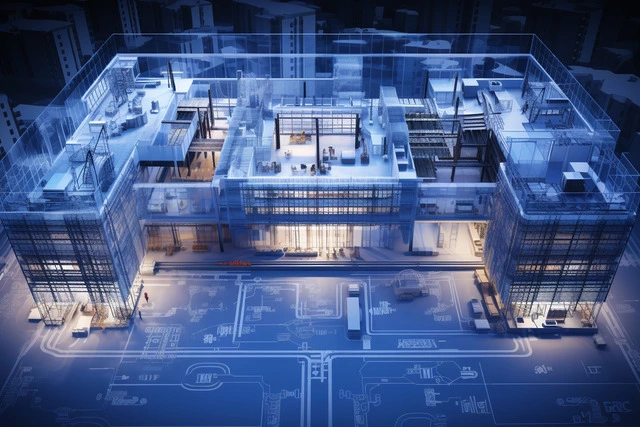In the construction and engineering industry, digital twin technology creates a virtual clone of a physical asset, such as a building or a bridge. They act as a high-tech twin that mimics real-world behavior and provides valuable insights in real-time. The digital twin enables immediate monitoring, simulation, and analysis to inform decisions with projected models based on real data.
What is the use of digital twins in construction project management?
Digital twins are superheroes in construction project management, transforming how projects are planned, executed, and monitored. These virtual replicas bring instant insights, improved collaboration, and more intelligent decision-making. By collecting data from sensors and systems, digital twins allow early detection of issues, reducing risks and ensuring project success.
What the AEC industry should know about digital twins
The AEC (Architecture, Engineering, and Construction) industry is on the brink of a digital revolution, with digital twins leading the way. To harness the potential of digital twins effectively, here are five best practices for using digital twins in the AEC industry:
- Embrace the shift: Recognize the transformative power of digital twins and their impact on project management.
- Value data: Collect accurate and comprehensive data from various sources to enable real-time insights and informed decision-making.
- Foster collaboration: Break down silos and encourage teamwork to leverage the collective expertise of project stakeholders.
- Invest in skills: Provide training in digital twin technologies, data analysis, and collaboration tools to maximize the benefits of digital twins.
- Address challenges: Overcome data integration, system compatibility, and cybersecurity issues to protect project information and ensure the integrity of digital twin ecosystems.
Advances and challenges
With digital twins, project teams can access up-to-date information, make informed decisions, and improve overall project performance. It also promotes data-driven real estate by making data easier to use and understand.
Collaboration among stakeholders is facilitated, promoting effective communication and problem-solving. Additionally, predictive analysis enables project teams to anticipate challenges, optimize designs, and proactively address potential issues.
But, to access these advancements, teams need to overcome a few key challenges. One of the critical challenges is data integration, as it requires standardized data formats such as RealEstateCore, robust data management systems, and effective data-sharing protocols. Privacy and security concerns also arise due to the extensive data collection involved in digital twin technology.
The purpose of digital twins in construction
Digital twins serve a wide range of purposes at different stages of the construction cycle, including:
- Planning and design: With digital twins, architects and engineers can visualize and test different scenarios before construction begins to save time, reduce errors, and avoid unexpected costs.
- Construction and operations: During the construction phase, digital twins provide real-time monitoring to help project managers track progress, identify issues, and ensure projects stay on schedule and within budget. They also enhance communication between the design team and the construction team.
- Maintenance and facility management: Predictive maintenance features of digital twins prevent costly breakdowns and offer deeper insights into asset performance and condition.
- Lifecycle optimization: Digital twins gather valuable data over time, allowing construction professionals to make informed decisions, enhance sustainability, and drive innovation.
What is the role of digital twins in decarbonizing construction?
Decarbonizing construction requires more efficient building processes with a higher priority on sustainability. ESG green buildings create a framework for decarbonizing construction. Digital twins can help meet ESG Green Buildings standards by simulating and optimizing building systems and construction activities. They can support sustainable practices throughout the lifecycle of constructed assets.
Taking the BIM process further with digital twins
While BIM already offers significant benefits for the construction industry, digital twins take these benefits a step further by enabling:
- Dynamic visualization and simulation: Creating virtual replicas of assets using instant data enables interactive exploration and scenario simulation for better decision-making.
- Real-time monitoring and performance analysis: Monitoring assets simultaneously with sensor data allows for proactive maintenance and optimization of asset performance.
- Collaboration and communication: Digital twins foster seamless cooperation between teams and stakeholders, improving coordination and decision-making.
- Predictive analytics and data-driven insights: Providing insights from analyzing historical and real-time data support proactive decision-making and resource optimization.
Part of the entire building process
Digital twin technology revolutionizes every stage of the building process. In the design phase, virtual replicas of buildings enable stakeholders to explore designs, test ideas, and make informed decisions. During construction, digital twins enhance project management, coordination, and productivity.
For the operation and maintenance phase, continuous monitoring and data integration optimize building operations and allow for preventative maintenance. They can also integrate into building management systems to uncover insights that improve operational efficiency. Even in renovation projects, digital twins facilitate accurate assessments, informed decision-making, and cost-effective retrofits.
Creating digital twins using ProptechOS
ProptechOS is an advanced platform that revolutionizes how digital twins are created in the construction and engineering industry. It seamlessly integrates technologies and data sources to develop comprehensive digital twins that model all building systems.
How can ProptechOS help facilitate?
ProptechOS collects and analyzes data from various sources by serving as a central hub, ensuring accurate and realistic digital twins that reflect real-world building performance.
Throughout the building process, ProptechOS empowers stakeholders to leverage digital twins effectively. Designers can explore ideas and improve designs, while construction teams benefit from real-time collaboration and project tracking. Additionally, ProptechOS enables building performance monitoring and proactive maintenance, enhancing operational efficiency and occupant satisfaction.
Try ProptechOS for free today to see how creating digital twins of your physical assets can improve your processes.
